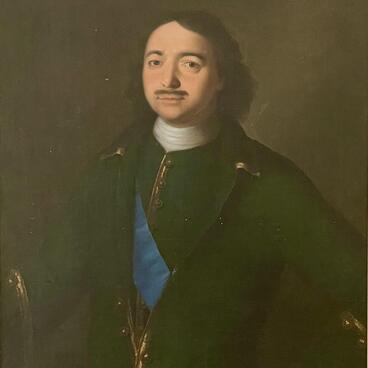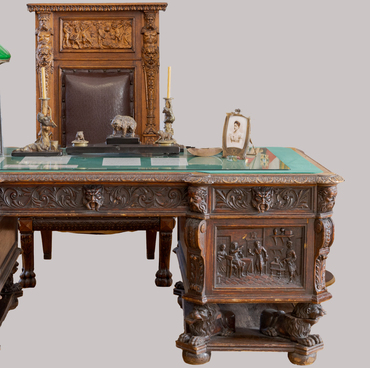The Roosevelt office, or the former waiting room of Nicholas II at the Livadia Palace Museum houses a polished desk. This is an exact copy of the desk where the negotiations between General Secretary of the Soviet Communist Party Joseph Stalin and President Franklin Roosevelt of the United States took place on February 8, 1945. The Allies discussed the secret Far Eastern Issue concerning the declaration of war against Japan by the Soviet Union after the defeat of Nazi Germany. After the Great Patriotic War, the original desk was lost.
The polished rectangular desk is made of several types of wood and decorated with carving. The tabletop rests on two carved rectangular columns. Another two carved elements are attached along the longer bottom sides of the frame on which the tabletop is placed. At the bottom, the columns are connected by a large crossbeam. Above it, there are two horizontal beams connected by four crisscross ones. The table stands on four small legs.
Between 1945 and 1953, the Livadia Palace housed a state dacha. In 1953, the building was handed over to the Ministry of Health and the All-Union Central Council of Trade Unions. Since 1974, the Livadia Sanatorium featured an exhibition hall “Historical and Memorial Complex ‘The Crimea Conference of the Three Allied Powers’ and Art Gallery”. In 1977, it was transformed into the Livadia Exhibition Complex. In 1985, to mark the 40th anniversary of the Yalta Conference, Head of the Livadia Exhibition Complex Alexander Kosovsky initiated the reconstruction of the Roosevelt office. The factory from Sochi that had originally manufactured furniture for the Crimea Conference was commissioned to produce a polished desk and a sofa. The Yalta architect Valery Savlayev helped to recreate the interior of the exhibition complex. The reconstruction was based on the 1945 photos from the Livadia Palace archive and collection. In 1993, the Livadia History and Art Complex gained the status of a museum.
The polished rectangular desk is made of several types of wood and decorated with carving. The tabletop rests on two carved rectangular columns. Another two carved elements are attached along the longer bottom sides of the frame on which the tabletop is placed. At the bottom, the columns are connected by a large crossbeam. Above it, there are two horizontal beams connected by four crisscross ones. The table stands on four small legs.
Between 1945 and 1953, the Livadia Palace housed a state dacha. In 1953, the building was handed over to the Ministry of Health and the All-Union Central Council of Trade Unions. Since 1974, the Livadia Sanatorium featured an exhibition hall “Historical and Memorial Complex ‘The Crimea Conference of the Three Allied Powers’ and Art Gallery”. In 1977, it was transformed into the Livadia Exhibition Complex. In 1985, to mark the 40th anniversary of the Yalta Conference, Head of the Livadia Exhibition Complex Alexander Kosovsky initiated the reconstruction of the Roosevelt office. The factory from Sochi that had originally manufactured furniture for the Crimea Conference was commissioned to produce a polished desk and a sofa. The Yalta architect Valery Savlayev helped to recreate the interior of the exhibition complex. The reconstruction was based on the 1945 photos from the Livadia Palace archive and collection. In 1993, the Livadia History and Art Complex gained the status of a museum.



